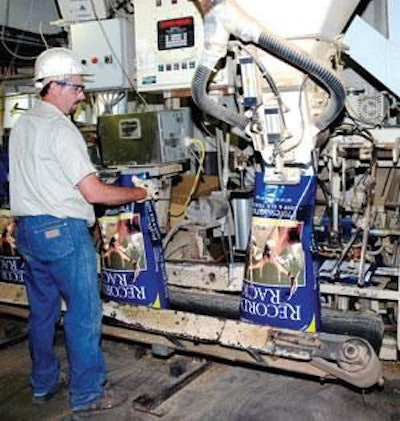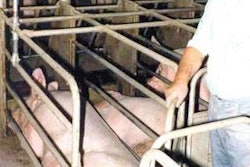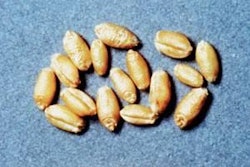
It is too soon to autopsy the feed industry's long-time standard packaging materials, including brown kraft paper and multi-wall paper bags, sewn jute sacks, and conventional woven polypropylene bags. Feed manufacturers are finding ways to upgrade these basic packages with plastic moisture-barrier liners, sealing tape closures, and other improvements. However, advancing consumer packaging and retail and wholesale level logistics technology offer much that is new and increasingly affordable in animal feed packaging.
One of the simplest, but most pervasive, shifts is toward durable and economical woven polypropylene bags, available in a wide range of designs, types of construction, and varieties of technical coatings and printing surfaces. These bags are available through international suppliers such that a multi-national feed company can provide the same packaging technology from country to country. For example, the 2006 Feed Mill of the YearCargill Animal Nutrition at Giddings, Texas, USA is North America's top feed plant selected in the annual programme sponsored by the American Feed Industry Association and FEED MANAGEMENT magazine. The Cargill-Giddings plant helped pioneer the use of poly' bags for dozens of other Cargill feed mills in the USA and Canada.
Going 'poly' and 'tubular'
Built originally to manufacture large quantities of bulk poultry feeds, over the past 20 years Cargill-Giddings changed its manufacturing and packaging capabilities continuously to meet changing customer needs. By mid-2006, Cargill-Giddings sales tonnage had risen to around 135,000 tonnes and product mix affirmed ‘cattle as king': Beef feed products, 49%; horse products, 25%; poultry products for both meat and sport, 10-12%; and deer and other game products, 6-8%. Even more diverse products made up the remaining 6-8% of tonnage, including pelleted shrimp feeds for producers near the Gulf in Texas and Mexico.
Moreover, what had been predominately bulk feed output when the Giddings plant was built, evolved to 70% bag output. This year, Cargill-Giddings has been floor-stocking more than 140 products, mostly for distribution by contract hauler to 275 Nutrena dealers in an area 800 km east-to-west and 1,200 km north-to-south, including transhipment in the Rio Grande valley to Mexican trucks for delivery to Monterrey and other points in Mexico.
One of the challenges of plant manager Byron Sommerlatte and other members of the Cargill-Giddings team in 2004 was to adapt the bagging lines and downstream conveyors and palletisers for the new poly bags. The poly bags behave differently in semi-automated and automated bagging systems, which can require some trial and error work to determine precise settings for best performance. In any case, Mr Sommerlatte says, the poly bags are less prone to tears and splits than conventional kraft paper bags, which reduces problems in the warehouse, in transport, and at dealer stores.
Another bag type increasingly popular in feed and petfood applications is the ‘super-tube' which the USA-based manufacturer Coating Excellence International reports is seamless, moisture resistant, and extremely durable: "Unwanted tears are virtually eliminated."
The double-sided woven tubular laminated bags offer a high-gloss surface for colourful printing with ink bonded between layers of laminate for additional protection. The manufacturer notes that the bag uses "environmentally friendly water-based inks", offers a number of closure options, and runs well on automated equipment. It is capable of higher resolution line screen printing and offers increased oil and grease-through' resistance.
Running RFID
Pressure from big consumer retailers, particularly Wal-Mart, is pushing radio frequency identification (RFID) technology upstream to suppliers, including feed manufacturers. Sources estimate that Wal-Mart alone, as the world's largest retailer operating more than 6,100 stores in 15 countries, requires about 1 billion RFID tags, mainly on pallets of consumer goods shipped by suppliers into its warehouses and retail locations worldwide. The global retailer's attraction to RFID technology mostly relates to inventory management, improving ‘just-in-time-delivery' of stock to prevent ‘stock-out' problems which send impatient consumers to other stores.
While suppliers also benefit from advances in inventory management, they also can take advantage of the cost-lowering effect on the technology as the RFID industry rapidly expands to meet retailers' needs. A study by DePaul University in the USA, sponsored by market research firm USA Strategies, describes the rapid decline in the cost of RFID chips and the corresponding rise in intranet and web-based systems relying on data from RFID tags. North America's grain industry already is taking advantage of the lower cost of RFID tags and the increased data management power and flexibility of RFID-based systems (see FEED MANAGEMENT's May-June 2006 issue for RFID: New technology for feed applications' in the Article Archive at www.feedindustrynetwork.com).
Moreover, feed makers also can use RFID-based systems to meet certain special feed and food safety requirements, such as improved upstream traceability of feedstuffs and downstream trackability of feed products.
Moreover, RFID technology can go beyond simple identification. For example, already a RFID system can help processors monitor temperature and humidity data of food products as they move through a global supply chain, enabling them to comply with new food safety requirements on traceability. Wal-Mart for one is developing traceability standards for all fresh products.
One RFID supplier, Savi Technology, says its new RFID sensor tags can be put on metal, plastic, wood or cardboard containers to help processors automatically locate goods in the supply chain. These RFID components have up to 128 kb of memory for recording environmental status data. The company says that when users commission the tags, they can set acceptable temperature and humidity ranges specific to the characteristics of the particular products to be monitored.
If temperature or time data falls outside the acceptable range, the ‘sensor tag' sends a real-time alarm to a fixed or mobile RF reader, and notification of the temperature or humidity change is sent via internet, mobile phone, or e-mail "allowing the problem to be addressed before spoilage or damage occurs."
Moreover, Savi says, complete environmental event logs can be uploaded to handheld readers or to fixed readers at stationary sites such as yards and warehouses in the supply chain: "This enables users to identify the time and location of unacceptable environmental conditions, or to confirm that acceptable ranges, and therefore shipment quality, are maintained."
‘High barrier' materials
Many feed manufacturers also are petfood manufacturers, who compete in consumer markets on the shelves of speciality petfood retailers, mass market retail outlets, and supermarkets. Their product packaging is some of the most sophisticated for any consumer product as petfood bags must keep product fresh and appealing, protecting the product from environmental impacts and the consumer from grease migration, and other unsightly effects.
Dr Alexis Stassinopoulous of the World Packaging Organisation (www.worldpackaging.org) has noted a number of packaging advances in a recent issue of PETFOOD INDUSTRY magazine, including:
'High barrier' films composed of ethylene vinyl alcohol (EVOH), polyvinylidene chloride (PVdC), metallocene polymers, liquid crystal polymers, as well as coatings made from nanocomposites, aluminum oxide (AlOx), silicon oxide (SiOx) and organically-modified ceramics or ormocers'; and
‘Active packaging' encompassing packaging containing ‘oxygen scavengers' to prevent the oxidation of oils and fats and the growth of aerobic micro organisms in order to increase the product shelf life, and modified gas atmospheres, which have an inert preservative effect allowing longer shelf life than ordinary air.
For more on petfood packaging, see PETFOOD INDUSTRY June 2006 at www.petfoodindustry.com.
Moreover, feed makers also can use RFID-based systems to meet certain special feed and food safety requirements, such as improved upstream traceability of feedstuffs and downstream trackability of feed products.
Moreover, RFID technology can go beyond simple identification. For example, already a RFID system can help processors monitor temperature and humidity data of food products as they move through a global supply chain, enabling them to comply with new food safety requirements on traceability. Wal-Mart for one is developing traceability standards for all fresh products.
One RFID supplier, Savi Technology, says its new RFID sensor tags can be put on metal, plastic, wood or cardboard containers to help processors automatically locate goods in the supply chain. These RFID components have up to 128 kb of memory for recording environmental status data. The company says that when users commission' the tags, they can set acceptable temperature and humidity ranges specific to the characteristics of the particular products to be monitored.
If temperature or time data falls outside the acceptable range, the sensor tag' sends a real-time alarm to a fixed or mobile RF reader, and notification of the temperature or humidity change is sent via internet, mobile phone, or e-mail "allowing the problem to be addressed before spoilage or damage occurs."
Moreover, Savi says, complete environmental event logs can be uploaded to handheld readers or to fixed readers at stationary sites such as yards and warehouses in the supply chain: "This enables users to identify the time and location of unacceptable environmental conditions, or to confirm that acceptable ranges, and therefore shipment quality, are maintained."


.jpg?auto=format%2Ccompress&fit=crop&h=167&q=70&w=250)














